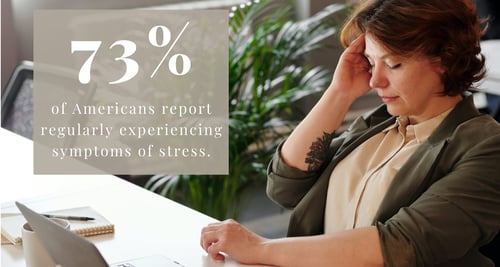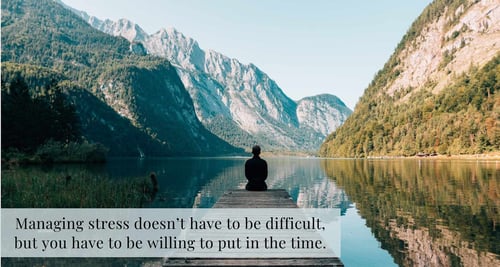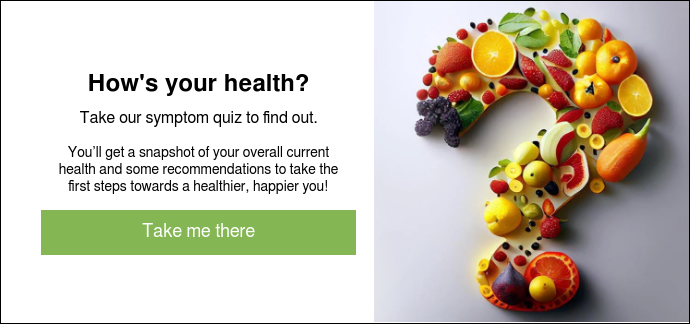Forty-eight percent of Americans report increased stress over the last 5 years.1 That’s not even counting the record-breakingly stressful year of 2020 yet. Experiencing stress is part of being human, and stress is not always a bad thing. Stress is a survival mechanism. For most of human history, it has been an important way to detect change. For our ancestors, change and danger were often synonymous. They needed a tool to protect themselves, and their nervous system delivered.
In our modern lives, we are able to rationalize and understand that that change isn’t always bad, but that doesn’t undo thousands of years worth of visceral reactions. While we now have more control over how we choose to perceive stress, we sometimes come up against our evolutionary wiring.
First, it’s important to understand exactly what stress is. Stress is our body reacting to a situation that creates tension. When you perceive something as new, exciting, uncertain, or overwhelming it can trigger a stress response.
You might commonly consider stress as a reaction to your surroundings, such as giving a talk or competing at a sporting event, troubles at work, or strain in a relationship. While these situations do cause stress, so, too, do chronic illness, sleep deprivation, and pain. Understanding your unique stressors is the first and possibly the most important step of stress management.
What Causes Stress
Stress activates your “fight or flight” response. It’s helpful for day-to-day emotions like ambition, excitement, and determination. If it wasn’t for stress, we’d feel no motivation to practice an upcoming speech or meet a deadline for a project. These types of “acute” (short-term) stress can be a healthy part of keeping us productive and functioning optimally.
However, the majority of the stress we feel isn’t the good kind, and it takes a toll on our mental and physical health. Chronic stress is what you feel as you commute to a job you’re unhappy at or as medical bills start to pile up on your kitchen table, or if you routinely eat foods that cause inflammation and blood sugar imbalance in your body. Chronic stress exposure is more damaging than acute stress and the distinction can be better understood by considering something called the allostatic load, a term coined by researcher Bruce McEwen in 1993.2
Allostatic load refers to the wear and tear on mental health and the physical body which accumulates as an individual is exposed to repeated or chronic stress. One small episode won’t do much on its own, but when you compile lots of small episodes together over time, the damage becomes clear. Like the tread on a set of new tires, one or two trips won’t show a noticeable difference. Check again after a year of driving, and they’ll be noticeably worn down.
How you perceive and respond to sources of stress in your life also affects the allostatic load felt by your body and mind. Believe it or not, we hold a lot of individual power over stress. When you alter your perception of stressful events, you have more control over how you respond to them.
How Stress Affects Your Health
Too much stress causes both physical and mental health problems. Individual symptoms manifest differently for everyone, but the most common ones are:
- Change in appetite — eating too much (stress eating) or too little is common when you’re feeling stressed out. So is replacing healthy foods with “comfort foods.” This happens because stress causes your brain to secrete hunger hormones like ghrelin which makes you crave fatty, starchy foods. Stress hormones like cortisol also cause you to eat more carbohydrates, which makes sense if you are needing to fight off other animals or run long distances, but this becomes an evolutionary mismatch in our modern stressful but sedentary lives. Leptin, insulin and cortisol also fluctuate when you’re stressed. These hormones help tell your brain when you feel full, and an imbalance can cause excess or inadequate food consumption.3
- Upset stomach — increased stress levels disrupt digestion, causing abdominal pain and heartburn, appetite fluctuation, constipation, diarrhea, and vomiting.
- Headaches — stress headaches are a common symptom following an episode of acute stress. They can also be a cumulative result of chronic stress. Headaches can also be caused by stress-related high blood pressure.
- Cardiovascular problems - stress hormones like cortisol raise your blood pressure and elevate your heart rate. With long-term exposure, we see an increased risk of heart attack, stroke, and many other issues.4
- Frequent illness — stress weakens the immune system and makes you susceptible to infections.5
- Muscle tension — your body's reaction to a stressful situation is to clench up, causing muscle strain and tension, and chronic pain.

- Feeling unfocused — stress puts your brain into survival mode. This pushes everything else into the background, making you feel unfocused and foggy, lowering your attention and productivity.
- Grinding teeth — clenching your jaw or grinding your teeth is most common at night, and stress is a known trigger.
- Sleep disturbances — almost half of all Americans report sleep disturbances as a direct result of stress.1 Much like stress eating, this results in more stress and triggers a vicious cycle.
- Feeling overwhelmed, depressed, or anxious — mental illness can be both a trigger and a result of stress.
The Mind-Body Connection
Since both your mind and your body are affected by stress, it’s important to address both. Physical illness can make you stressed, and stress can make you physically ill.
We’ve also learned from disorders like PTSD that traumatic events significantly increase your risk of chronic and acute stress disorder.6
This is especially true when these events happen in childhood, and the negative effects can follow you throughout your adult life. The Adverse Childhood Experiences or ACE method measures a persons’ exposure to traumatic events early in life. A high score increases the risk for a variety of chronic illnesses and lowers tolerance to stress exposure. A high ACE score means you’re at increased risk for chronic stress and increased allostatic load.7
Autoimmune disease, inflammation, and an imbalanced limbic system are also common in people with high ACE scores. Dr. Gabor Mate further explores this connection in his powerful book “When the Body Says No.”8
Another example of the mind-body relationship is the degree to which our nervous system responds to stress. Our brain responds to stress by using something called the autonomic nervous system. The autonomic nervous system is divided into two parts; the sympathetic nervous system and the parasympathetic nervous system. The sympathetic nervous system generates energy and activates your “fight or flight” response. The parasympathetic system relaxes the body, promoting a sense of calm.
These two systems are meant to work together in balanced harmony but prolonged stress can tip the scales in favor of the sympathetic nervous system. This leaves you in a state of near-constant tension.
You might think you have no control over these systems, but thanks to something called the ventral vagus nerve, that’s not entirely true. The ventral vagus nerve controls your parasympathetic nervous system, and you can activate a relaxation response by performing special exercises and techniques like breathwork, gargling, and cold exposure.9 Activating the vagus nerve is a very effective way to reduce the negative impact of stress, because it’s a tool of your body’s own design. Vagus nerve stimulation also improves cognition and reduces inflammation.9
The polyvagal theory addresses the activation of the autonomic nervous system. It’s proposed (and well-supported) that activation of the ventral vagus nerve rather than the sympathetic dorsal vagus nerve supports a state of calm and well-being. This is called a phylogenetic shift.10
If you’d like to learn more about the polyvagal theory for stress relief or to learn how to activate your ventral vagus nerve, check out our new online Stressful Times Toolkit, a comprehensive 6-week course designed to help you better recognize and manage stress (more on this later).

How to Deal With Stress
So you know that stress is bad for you. What now? It’s often unavoidable and being told to “just relax” accomplishes little. The best way to deal with stress is to shift your perception and learn how to redirect negative energy. Changing your perception of stress to one of acknowledgment and redirection is called “mindfulness-based stress reduction.” This isn’t always an easy process, but there’s no shortage of resources and support to help you along the way. Learning how to release stress is a personal journey, so you have to experiment to find what works for you.
- Mindset — perception is everything. You don’t have to bring that rough day at work home with you. You can lower the negative burden of this stress on you and your loved ones by reminding yourself about the positive aspects of your work, and how your job and career brings good things to you, your family, and your life. Sure, it’s easier said than done. But there are resources abound to help you shift your mindset to make negative stress less powerful in your life. Withhold power from negative thoughts.
- Deep breathing and focused breathwork — deep breaths and special breathing techniques lower your heart rate, calm your mind, and reduce your blood pressure.11 It's one of the most effective known relaxation techniques. In fact, when we work with first responders, we have repeatedly demonstrated that a quick 10-minute breathing exercise lowers perceived stress by 25-30% and lowers heart rate by 6-8 beats per minute.
- Physical activity — remember that since stress activates your sympathetic nervous system, it’s going to make you feel jumpy and excitable. Exercise is a great way to redirect that negative energy. Physical activities like yoga, tai chi, and qigong release endorphins that fight stress. If you want a comprehensive guided program, take a look at the qigong course we created.
- Sunlight — sunlight is an excellent stress reliever. It activates the pineal gland, a small part of your brain that controls stress hormones. When you’re exposed to sunlight, the pineal gland produces a hormone called serotonin. Serotonin is a neurotransmitter that promotes relaxation and a “good mood.” Getting some sunlight every day keeps the pineal gland producing serotonin, which helps stave off stress and depression.12 Just don’t overdo it. Melanoma, the most dangerous type of skin cancer, is a result of too much sun exposure. The safest way to get your sunlight is to aim for the morning hours and limit your exposure time. Morning sun exposure can also be a powerful way to reset your circadian rhythm and improve your sleep.
- Meditation and aromatherapy — meditation takes practice to get right, but that’s part of the fun. Over 40% of Americans meditate regularly and report significant improvements in their quality of life after doing so.13 Supplementing meditation with aromatherapy like lavender and lemon balm add an additional calming effect.
- Apps — modern problems call for modern solutions. There’s a slew of apps that teach and guide stress management techniques. Some of our favorites are Buddhify, Insight Timer, Calm, and Headspace.
While all the above stress management techniques are effective, it’s important that you seek professional help if you’re feeling overwhelmed by stress.
Embracing Stress
In our modern society, more people than ever are experiencing burnout and other negative effects of stress. Stress is always going to be part of your life so it’s important to learn how to manage it. With the right tools and support, you can learn to channel energy born from stress into something constructive. Coping with stress is a lifetime commitment, but the benefits are immeasurable, and even small changes can help you feel empowered.
Practice a few stress management techniques to find the ones you like best. Learn which ones work for you so that you can use them in real-time. The best time to manage stress is before it overwhelms you.
The foundation of functional medicine is to treat the underlying cause of your illness in order to achieve optimal wellness. Stress is a significant trigger for both acute and chronic illnesses, so it’s a condition we take seriously.
With this in mind, we do hope that you will join our Stressful Times Toolkit so that together we can learn how to mitigate stress and avoid stress injury. In this course, we will teach you about different types of stress, how to isolate your stressors, and we will give you a hands-on introduction to many of the most effective stress management techniques and tools. To learn more about our program click here and also sign up for our newsletter for updates.
Between health fears, financial instability, and isolation, we can all benefit from stress relief after the year we’ve had. Times like these are a perfect reminder that self-care is an essential part of optimal health and well-being. It’s also a perfect reminder that we’re all in this together.
References:
- The American Institute of Stress (2019). Daily Life. Retrieved from https://www.stress.org/daily-life. Accessed 16 December 2020.
- McEwen B. S. (1998). Stress, adaptation, and disease. Allostasis and allostatic load. Annals of the New York Academy of Sciences, 840, 33–44. https://doi.org/10.1111/j.1749-6632.1998.tb09546.x. Accessed 16 December 2020.
- Chao, A. M., Jastreboff, A. M., White, M. A., Grilo, C. M., & Sinha, R. (2017). Stress, cortisol, and other appetite-related hormones: Prospective prediction of 6-month changes in food cravings and weight. Obesity (Silver Spring, Md.), 25(4), 713–720. https://doi.org/10.1002/oby.21790. Accessed 16 December 2020.
- Yaribeygi, H., Panahi, Y., Sahraei, H., Johnston, T. P., & Sahebkar, A. (2017). The impact of stress on body function: A review. EXCLI journal, 16, 1057–1072. https://doi.org/10.17179/excli2017-480. Accessed 16 December 2020.
- Dragoş, D., & Tănăsescu, M. D. (2010). The effect of stress on the defense systems. Journal of medicine and life, 3(1), 10–18. https://pubmed.ncbi.nlm.nih.gov/20302192/. Accessed 16 December 2020.
- American Psychiatric Association (2020). What is Posttraumatic Stress Disorder? Retrieved from https://www.psychiatry.org/patients-families/ptsd/what-is-ptsd. Accessed 16 December 2020. Accessed 16 December 2020.
- Dube, S. R., Fairweather, D., Pearson, W. S., Felitti, V. J., Anda, R. F., & Croft, J. B. (2009). Cumulative childhood stress and autoimmune diseases in adults. Psychosomatic medicine, 71(2), 243–250. Accessed 16 December 2020.https://doi.org/10.1097/PSY.0b013e3181907888
- Mate, G. Dr. (2003) When the Body Says No - Exploring the Stress-Disease Connection. Knopf. (1st Edition).
- Bremner, J. D., Gurel, N. Z., Wittbrodt, M. T., Shandhi, M. H., Rapaport, M. H., Nye, J. A., Pearce, B. D., Vaccarino, V., Shah, A. J., Park, J., Bikson, M., & Inan, O. T. (2020). Application of Noninvasive Vagal Nerve Stimulation to Stress-Related Psychiatric Disorders. Journal of personalized medicine, 10(3), 119. https://doi.org/10.3390/jpm10030119 Accessed 16 December 2020.
- Porges S. W. (2009). The polyvagal theory: new insights into adaptive reactions of the autonomic nervous system. Cleveland Clinic journal of medicine, 76 Suppl 2(Suppl 2), S86–S90. https://doi.org/10.3949/ccjm.76.s2.17
- Stächele, T., Domes, G., Wekenborg, M., Penz, M., Kirschbaum, C., & Heinrichs, M. (2020). Effects of a 6-Week Internet-Based Stress Management Program on Perceived Stress, Subjective Coping Skills, and Sleep Quality. Frontiers in psychiatry, 11, 463. https://doi.org/10.3389/fpsyt.2020.00463 Accessed 16 December 2020.
- Mead M. N. (2008). Benefits of sunlight: a bright spot for human health. Environmental health perspectives, 116(4), A160–A167. https://doi.org/10.1289/ehp.116-a160 Accessed 16 December 2020.
- Dunlop J. (2015). Meditation, stress relief, and well-being. Radiologic technology, 86(5), 535–559.https://pubmed.ncbi.nlm.nih.gov/25995404/ Accessed 16 December 2020.






